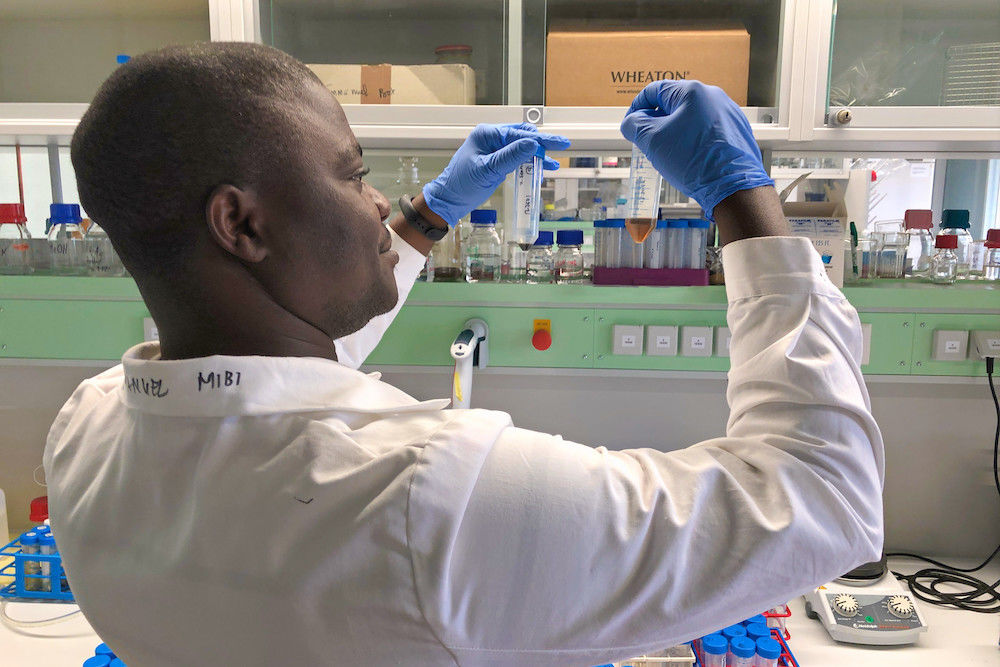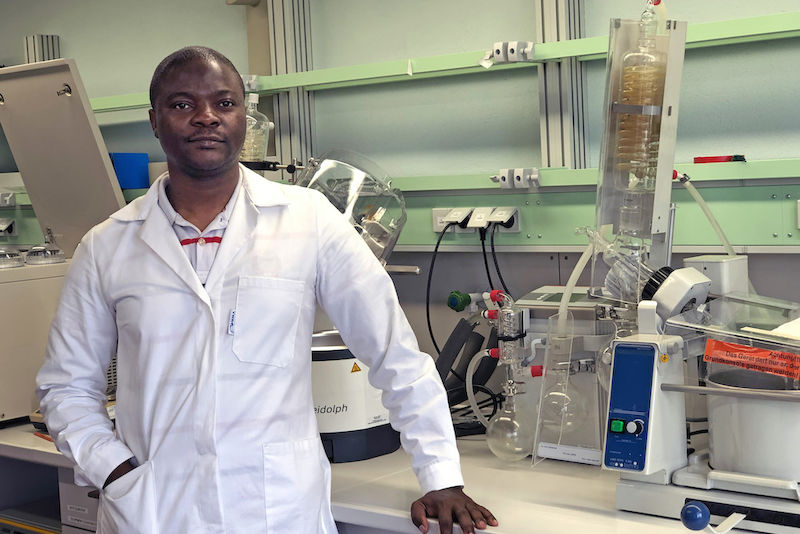Secrets of the wonder shrub

In western Cameroon, as in many African regions, traditional medicine plays a major role. Emmanuel Njoya grew up there, in a village in the Noun district. "When you are sick, you first go to the healer", he says. "And he gives you something herbal – usually roots or leaves." Only if that doesn't work, he says, does the healer send his patients to hospital.
The plants that traditional healers use are increasingly the focus of research. It is not uncommon for them to contain unknown active ingredients. Njoya has been researching for many years to isolate such substances and make them medically usable. Coincidence led him to his current research project, which he is currently continuing in the working group of Professor Timo Niedermeyer at the Institute of Pharmacy. "Actually, I wanted to become a doctor, but I didn't pass the entrance examination", Njoya recounts. In Cameroon, the now 37-year-old studied biochemistry at the University of Yaoundé I instead. Later, he specialised in biopharmacy as part of his master's thesis.
The working group in which he conducted research for his thesis had collected various plants from the region where Njoya also comes from. They were looking for a new active ingredient against amoebic dysentery, caused by the protozoan Entamoeba histolytica. "The disease is one of the most common parasitic diseases", explains Njoya. In many cases it is harmless, but in some it is fatal – 40,000 to 100,000 people fall victim to it worldwide every year. "Amoebic dysentery has been treated with the same drug for 30 years, but it has many side effects." It is high time for an alternative, he says.
Traditional healers in Cameroon use different plants against amoebic dysentery. The scientists found that one works particularly well against the parasites: Codiaeum variegatum, the fire croton, which in Germany is also known as “wonder shrub” and is used as an ornamental plant worldwide. In traditional medicine, its leaves are brewed like tea and the brew is drunk. As a doctoral student, Njoya tried to isolate the substance from the “wonder shrub” that helps against amoebic dysentery. No easy task, since one plant consists of thousands of substances. And not only that: "The problem was that we didn't have the equipment in Cameroon to carry out all the necessary tests."
In order to track down the active ingredient, Njoya went on research visits first to the Institut Pasteur in Paris, then to the University of Würzburg. Instead of looking at all the substances individually that he had extracted from the leaves of the plant, he separated the mixture into eight parts, examined them and then separated them into even smaller parts. The most effective of these he investigated further. As part of his doctoral thesis, Njoya was even able to conduct a small study with patients. There is a movement in Cameroon to professionalise traditional medicine and also offer it in pharmacies. "We call this improved traditional medicine", says Njoya. For his study, he filled tea bags with a certain amount of powder from the leaves of the fire croton and cooperated with a doctor who handed them out to patients. "Thirty patients each drank one tea a day until they were symptom-free." Depending on the patient, a maximum of three tea bags were necessary, he said. Together with the doctor, he also conducted blood tests. "We could not find any side effects."
After Njoya finished his dissertation, he first researched other herbal agents in working groups in South Africa and China. And then he turned back to the “wonder shrub” project. In search of a research group with the necessary technical equipment to finally identify the active substance or even the active substance mixture from the fire croton, he came across Timo Niedermeyer at the University of Halle in 2018. "I then contacted Mr Niedermeyer and applied for a scholarship", Njoya recounts. The Georg Forster Research Fellowship allows him to conduct research in Halle for a total of two years, until the summer of 2021.
"I first isolated the two substances of which there was the most in my most effective mixture", he says. But the plant did not make it that easy for him; the substances were – at least individually – not effective. That is why Njoya has subsequently broken down the entire mixture into its individual parts – mostly a single substance, thirty in total. "I have tested them all individually. And some of them I’m now testing in combination", he explains. He has already found one promising substance. But it may also be that not one single substance is responsible for the effect but rather several. To test this, Njoya puts them on the amoebae – individually or in combination – and in an airtight fresh-keeping box. "The parasites only grow under anaerobic conditions", he explains. That is, when there is no oxygen in the air. That's why he adds a small bag with special materials that absorb the remaining oxygen from the box. This works just as well as far more expensive vessels for anaerobic experiments, which are otherwise not needed in Niedermeyer's lab.
The most promising active substance or substances he will investigate further and take a closer look at their chemical composition. That, in turn, will then be the first step to finding out how it works on a molecular level and whether it can be produced in larger quantities. Either way – the project, which the 37-year-old has already started in his Master's thesis, will keep him busy for a while.


Kommentare
F77 am 05.05.2021 23:09
Hilft der Tee auch bei Dientamoeba fragilis?
Reply
Redaktion "campus halensis" am 06.05.2021 15:53
Danke für die Anfrage, die wir gleich weitergegeben haben. Laut Dr. Emmanuel Njoya wurde der Tee bisher jedoch noch nicht an Dientamoeba fragilis getestet.
Reply